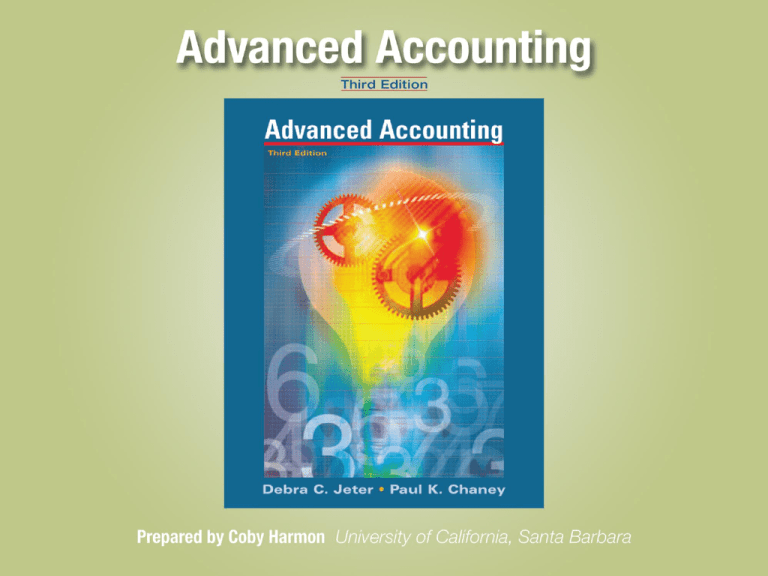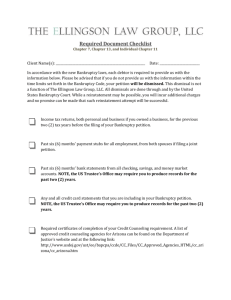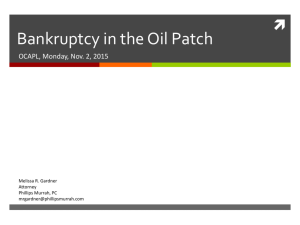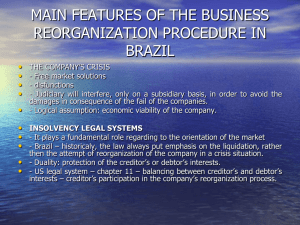
Chapter
10-1
10
Insolvency—Liquidation and
Reorganization
Advanced Accounting, Third Edition
Chapter
10-2
Learning Objectives
1.
Distinguish between a Chapter 7 and a Chapter 11
bankruptcy.
2.
Describe the five priority categories of unsecured claims
and list the order in which they are settled.
3.
Distinguish between a voluntary and involuntary
bankruptcy petition.
4.
Distinguish among fully secured, partially secured, and
unsecured claims of creditors.
5.
Describe contractual agreements that the debtor and its
creditors may enter into outside of formal bankruptcy
proceedings to resolve the debtor’s insolvent position.
Chapter
10-3
Insolvency
When a business becomes insolvent, it generally has three
possible courses of action:
1. Debtor and its creditors may enter into a contractual
agreement, outside bankruptcy;
2. Debtor or its creditors may file a bankruptcy petition,
after which the debtor is liquidated under Chapter 7 of
the Bankruptcy Reform Act; or
3. Debtor or its creditors may file a petition for
reorganization under Chapter 11 of the Bankruptcy
Reform Act.
Chapter
10-4
Insolvency
Review:
Insolvency means that a debtor has more
current liabilities than current assets.
False
Chapter
10-5
Contractual Agreements
A business that is unable to pay its obligations may reach
an accommodation with its creditors. Possibilities
generally include:
1. An extension of payment periods.
2. Composition agreements.
3. Formation of a creditors’ committee.
4. Voluntary assignment of assets.
Chapter
10-6
LO 5 Contractual agreements.
Contractual Agreements
Extension of Payment Periods
Statement of Financial Accounting Standard No. 15
Provides that where a debt restructuring involves only a
modification of terms of payment, the debtor should
account for the restructuring prospectively and not change
the carrying amount of the payable, unless the carrying
amount exceeds the total future cash payments of principal
and interest specified by the new terms.
No gain is recognized.
Chapter
10-7
LO 5 Contractual agreements.
Contractual Agreements
Composition Agreements
(Creditors Accept Less Than Full Amount)
Creditors are often given some immediate cash payment,
and the amount of the remaining debts and their interest
rates are renegotiated.
Formation of a Creditors’ Committee
Committee is responsible for managing the debtor’s
business affairs for the period during which plans are
developed to rehabilitate, reorganize, or liquidate the
business.
Chapter
10-8
LO 5 Contractual agreements.
Contractual Agreements
Voluntary Assignment of Assets
A debtor may elect to place its property under the control
of a trustee for the benefit of its creditors.
Any proceeds remaining after payment of the creditors,
are returned to the debtor.
Chapter
10-9
LO 5 Contractual agreements.
Bankruptcy
Provisions of the Bankruptcy Reform Act apply to
individuals, corporations, and partnerships, as well as to
municipalities seeking voluntary relief from their creditors.
A business unable to pay its obligations, may attempt to
negotiate with its creditors. If an agreement cannot be
reached, a legal petition for bankruptcy will be initiated by
either the
debtor (a voluntary petition) or its
creditors (an involuntary petition).
Chapter
10-10
LO 3 Voluntary vs. involuntary petitions.
Bankruptcy
Voluntary Petitions
A debtor may file a voluntary petition with a bankruptcy
court for;
liquidation under Chapter 7 or for
reorganization under Chapter 11.
Filing a voluntary petition constitutes an order for relief.
The bankruptcy petition (either voluntary or involuntary) is
an official form that initiates bankruptcy proceedings and
establishes an estate consisting of the debtor’s assets.
Chapter
10-11
LO 3 Voluntary vs. involuntary petitions.
Bankruptcy
Involuntary Petitions
Creditors initiate the action by filing a petition for
liquidation or reorganization with the bankruptcy court.
The bankruptcy court will generally enter an order for
relief against the debtor only if evidence indicates that
the debtor, in fact, has not been paying its debts as they
become due.
Chapter
10-12
LO 3 Voluntary vs. involuntary petitions.
Bankruptcy
Secured and Unsecured Creditors
Secured creditors are those whose claims are secured by
liens or pledges of specific assets.
If the proceeds from the sale of a pledged asset(s)
exceed the secured claim, the excess proceeds are
available for distribution to unsecured creditors.
Chapter
10-13
LO 4 Secured and unsecured creditors.
Bankruptcy
Review:
Voluntary bankruptcy petitions may be filed
under either Chapter 7 or Chapter 11 of the
Reform Act.
True
Chapter
10-14
LO 4 Secured and unsecured creditors.
Bankruptcy
Review:
Unsecured creditors with priority will
receive full satisfaction before secured
creditors are paid.
False
Chapter
10-15
LO 4 Secured and unsecured creditors.
Liquidation (Chapter 7)
A voluntary or involuntary petition for liquidation may be
filed under Chapter 7 of the Reform Act.
Upon filing, the bankruptcy court must decide whether to
accept or dismiss the petition.
Dismissals occur infrequently.
Debtor may dispute an involuntary petition.
If accepted,
an order for relief is entered and
the bankruptcy court will appoint an interim
trustee until a permanent trustee is selected.
Chapter
10-16
LO 7 Chapter 1 versus Chapter 7.
Reorganization Under Reform Act (Chapter 11)
Creditors of an insolvent debtor may believe their interests
would be served by rehabilitating or reorganizing the
debtor.
In such a case:
Creditors and debtor may agree to a plan for
reorganization.
Debtor or creditors may prefer to file with the
bankruptcy court a petition for reorganization under
Chapter 11 of the Reform Act.
Chapter
10-17
LO 7 Chapter 1 versus Chapter 11.
Reorganization Under Reform Act (Chapter 11)
Fresh Start Accounting and Quasi Reorganization
When firms emerge from bankruptcy, SOP 90-7 provides
for fresh start accounting.
Assets and liabilities are reported at fair values.
Beginning retained earnings is reported at zero.
Two conditions must exist:
Fair value of assets must be less than the post
liabilities and allowed claims, and
Original owners must own less than 50% of the voting
stock after reorganization.
Chapter
10-18
LO 7 Chapter 1 versus Chapter 11.
Reorganization Under Reform Act (Chapter 11)
Fresh Start Accounting and Quasi Reorganization
Quasi reorganization
Per Accounting Research Bulletin No. 43, three steps are
required:
1. Authorization from creditors and stockholders is
required.
2. All assets are revalued to fair values with losses
recorded in retained earnings.
3. The deficit in retained earnings is eliminated by
charging to (reducing) paid-in capital.
Chapter
10-19
LO 7 Chapter 1 versus Chapter 11.
Reorganization Under Reform Act (Chapter 11)
Accounting for Reorganization – Troubled Debt
Debt may be restructured in any one (or a combination) of
the following methods:
1. The debtor may transfer assets in full settlement of
the payable.
2. The debtor may give an equity interest in its firm in
full settlement of the payable.
3. The creditor may modify terms of the payable.
Chapter
10-20
LO 7 Chapter 1 versus Chapter 11.
Reorganization Under Reform Act (Chapter 11)
Accounting for Reorganization – Troubled Debt
Transfer of Assets
A debtor that transfers assets to a creditor in full
settlement of a payable recognizes a gain.
The gain is measured by the excess of the carrying value
of the payable over the fair value of the assets
transferred.
The difference between the fair value and the carrying
amount of the assets transferred is a gain or loss and is
reported as a component of net income for the period of
transfer.
Chapter
10-21
LO 7 Chapter 1 versus Chapter 11.
Reorganization Under Reform Act (Chapter 11)
Accounting for Reorganization – Troubled Debt
Grant of an Equity Interest
A debtor that issues an equity interest in its firm to a
creditor in full settlement of a payable shall account for
the equity interest at its fair value.
Difference between the fair value of the equity interest
issued and the carrying amount of the payable is reported
as a gain on restructuring.
Debtor determines its gain based on undiscounted cash
flows.
Chapter
10-22
LO 7 Chapter 1 versus Chapter 11.
Reorganization Under Reform Act (Chapter 11)
Accounting for Reorganization – Troubled Debt
Modification of Terms
A debtor, in a troubled debt restructuring involving only
modification of terms of a payable, accounts for the
effects of the restructuring prospectively from the time
of restructuring.
The carrying value of the payable is not changed at the
time of restructuring unless the carrying value exceeds
the total future cash payments specified by the new
terms.
Chapter
10-23
LO 7 Chapter 1 versus Chapter 11.
Reorganization Under Reform Act (Chapter 11)
Review:
In a reorganization involving a transfer of
assets, the debtor will recognize a gain on
restructuring measured by the excess of
the carrying value of the payable settled
over the book value of the assets
transferred.
False
Chapter
10-24
LO 7 Chapter 1 versus Chapter 11.
Reorganization – Transfer of Assets
E10-3 Bar Company, which is in financial difficulty and
in the process of a voluntary reorganization, has agreed
to transfer to a creditor a copyright it owns in full
settlement of a $150,000 note payable and $15,000 in
accrued interest. The copyright, which originally cost
$100,000, has an accumulated amortization balance of
$55,000 and a current fair value of $95,000.
Required:
a. Prepare the journal entries on Bar Company’s books
to record the transfer of the copyright.
Chapter
10-25
LO 7 Chapter 1 versus Chapter 11.
Reorganization – Transfer of Assets
E10-3 a. Prepare the journal entries on Bar Company’s
books to record the transfer of the copyright.
Copyright
50,000
Gain on Transfer of Assets
50,000
Revalue copyright to fair value. $95,000 – ($100,000 - $55,000)
Notes Payable
Chapter
10-26
150,000
Accrued Interest Payable
15,000
Accumulated Amortization – Copyright
55,000
Copyright ($100,000 + $50,000)
150,000
Gain on Debt Restructuring
70,000
LO 7 Chapter 1 versus Chapter 11.
Reorganization – Transfer of Assets
E10-3 b. Explain the proper treatment of any gain or
loss recognized in (A).
The gain on transfer of assets ($50,000) should be
reported as a separate component (assuming
material in amount) of operating income; the gain
on restructuring ($70,000) should also be reported
as a separate component of operating income.
Chapter
10-27
LO 7 Chapter 1 versus Chapter 11.
Reorganization – Transfer of Assets
E10-3 c. Assuming the fair value of the copyright was
$30,000, repeat the requirement in (A).
Loss on Transfer of Assets
15,000
Copyright
15,000
Revalue copyright to fair value. $30,000 – ($100,000 - $55,000)
Notes Payable
150,000
Accrued Interest Payable
15,000
Accumulated Amortization – Copyright
55,000
Copyright ($100,000 - $15,000)
85,000
Gain on Debt Restructuring ($165,000 - $30,000)
Chapter
10-28
135,000
LO 7 Chapter 1 versus Chapter 11.
Reorganization – Modification of Terms
E10-4 Lake Company, a major creditor of financially
troubled Spain Company, has agreed to modify the
terms of a debt owed to Lake Company. The debt
consists of a $900,000, 12% note that is due currently
along with accrued interest of $95,000. Lake Company
agreed to extend the due date of the note and accrued
interest for three years and to reduce the interest
rate to 5% per annum (on both maturity value and
accrued interest), with interest to be paid annually.
Required:
a. Should a gain on restructuring be recognized by
Spain Company? Explain.
Chapter
10-29
LO 7 Chapter 1 versus Chapter 11.
Reorganization – Modification of Terms
E10-4 a. Should a gain on restructuring be recognized
by Spain Company? Explain.
No gain should be recognized because the total
future cash payments specified by the new terms
of $1,144,250 ($995,000 carrying value plus 3
years’ interest at $49,750 per year) exceed the
current carrying value of the debt, $995,000.
Chapter
10-30
LO 7 Chapter 1 versus Chapter 11.
Reorganization – Modification of Terms
E10-4 b. Prepare the entry that should be made on
Spain Company’s books on the date of restructure.
Note Payable
Accrued Interest Payable
Restructured Debt
Chapter
10-31
900,000
95,000
995,000
LO 7 Chapter 1 versus Chapter 11.
Reorganization Under Reform Act (Chapter 11)
Review:
Restructuring gains that arise from troubled
debt restructurings are reported by the
debtor as extraordinary gains.
False
Chapter
10-32
LO 7 Chapter 1 versus Chapter 11.
Reorganization Under Reform Act (Chapter 11)
The “Accounting” Statement of Affairs
A plan for reorganization must show that creditors will
receive as much as if the debtor were liquidated.
The Statement of Affairs is an accounting report that is
designed to permit the user to determine:
the total expected amounts that could be realized on
the disposition of the assets,
the priorities in the use of the realization proceeds in
satisfying claims, and
the potential net deficiency that would result if the
assets were realized and claims liquidated.
Chapter
10-33
LO 7 Chapter 1 versus Chapter 11.
Reorganization Under Reform Act (Chapter 11)
E10-7 Ball Company is facing bankruptcy proceedings. A balance
sheet and other information are presented below:
Ball Company Balance Sheet - June 30, 2009
Cash
Accounts receivable
Inventory
Property and Equipment, net
$ 20,400
170,000
180,000
430,000
$ 800,400
Accounts payable
$ 350,000
Accured wages
120,000
Notes payable
200,000
Common stock
400,000
Retained earnings (deficit)
124,600
$ 1,194,600
Estimated realizable values:
Accounts receivable
$ 95,000
Inventory
110,000
Property and Equipment, net
320,000
Accounts receivable and inventory are each pledged as security on
individual notes payable in the amount of $100,000 each.
Chapter
10-34
LO 7 Chapter 1 versus Chapter 11.
Reorganization Under Reform Act (Chapter 11)
E10-7 Statement of Affairs
Book
Value
$ 180,000
170,000
20,400
430,000
Assets
Assets Pledged with Fully Secured Creditors:
Inventory
$ 110,000
Note Payable
100,000
Chapter
10-35
Deficiency
Account
(Loss) / Gain
$
Free Assets
Cash
Property and Equipment
Total Net Realizable Value
Liabilities having Priority – Wages
Net Free Assets
(70,000)
10,000
Assets Pledged with Partially Secured Creditors:
Accounts Receivable
95,000
Note Payable
100,000
Estimated Deficiency to Unsecured Creditors
$ 800,400
Realizable
Value
(75,000)
20,400
320,000
350,400
120,000
230,400
124,600
$ 355,000
(110,000)
$
(255,000)
Reorganization Under Reform Act (Chapter 11)
E10-7 Statement of Affairs
Book
Value
Equities
Liabilities Having Priority:
Accrued Wages
$ 120,000
100,000
Fully Secured Creditors:
Note Payable
100,000
Partially Secured Creditors:
Note Payable
`
350,000
400,000
(269,600)
$ 800,400
Unsecured Creditors:
Accounts Payable
Deficiency
Account
(Loss) / Gain
$ 120,000
100,000
100,000
95,000
5,000
350,000
Stockholders’ Equity
Common Stock
Retained Earnings (deficit)
$ 355,000
Estimated deficiency *
Chapter
10-36
Realizable
Value
$
400,000
(269,600)
130,400
$
(124,600)
* ($255,000) loss - $130,400 gain = $124,600 deficiency
Reorganization Under Reform Act (Chapter 11)
E10-7 Deficiency Account
BALL COMPANY
Deficiency Account
Estimated Losses
Accounts Receivable
$ 75,000
Inventory
70,000
Property and Equipment
110,000
$ 255,000
Chapter
10-37
Estimated Gains
Common Stock
$400,000
Retained Earnings
(269,600)
Estimated Deficiency to
Unsecured Creditors
124,600
$255,000
Reorganization Under Reform Act (Chapter 11)
Review:
The statement of affairs is a report
designed to estimate the amount expected
to be earned by a debtor company during the
time period needed to complete a
reorganization.
False
Chapter
10-38
LO 7 Chapter 1 versus Chapter 11.
Trustee Accounting and Reporting
Trustee takes title to the debtor’s assets and is
accountable to the court, the creditors, and other
parties for the subsequent utilization or realization of
the assets.
Trustee records the assets at their book values.
No existing liabilities are recorded by the trustee.
Payment of preexisting debts reduces the assets.
Chapter
10-39
LO 7 Chapter 1 versus Chapter 11.
Trustee Accounting and Reporting
E10-9 TRX Company has been forced into receivership.
The trustee has decided to open a new set of books to
distinguish between transactions occurring before and
after the appointment. The following account balances
were reported on September 1, 2009:
Cash
Accounts receivable
Inventory
Property and Equipment, net
$
26,700
130,400
191,900
590,400
$ 939,400
Allowance for uncollectibles
Accumulated depreciation
Accounts payable
Capital stock
Retained earnings (deficit)
$
16,000
211,500
308,400
800,000
(396,500)
$ 939,400
Required: Prepare journal entries to record the following
on the trustee set of books.
Chapter
10-40
LO 7 Chapter 1 versus Chapter 11.
Trustee Accounting and Reporting
E10-9 Record the receipt of TRX Company assets.
Cash
26,700
Accounts Receivable (old)
130,400
Inventory
191,900
Property and Equipment
590,400
Allowance for Uncollectibles (old)
16,000
Accumulated Depreciation
211,500
TRX Company – in Receivership *
711,900
* ($939,400 – $16,000 - $211,500)
Chapter
10-41
LO 7 Chapter 1 versus Chapter 11.
Trustee Accounting and Reporting
E10-9 1. Sales were made in the amount of $296,000, of
which $31,500 were cash sales.
Cash
Accounts Receivable (new)
Sales
Chapter
10-42
31,500
264,500
296,000
LO 7 Chapter 1 versus Chapter 11.
Trustee Accounting and Reporting
E10-9 2. Receivables were collected in the following
amounts:
Old receivables $ 76,800
New receivables 242,200
Cash
Accounts Receivable (old)
Accounts Receivable (new)
Chapter
10-43
319,000
76,800
242,200
LO 7 Chapter 1 versus Chapter 11.
Trustee Accounting and Reporting
E10-9 3. Additional inventory was purchased on account in
the amount of $127,500.
Purchases
Accounts Payable (new)
Chapter
10-44
127,500
127,500
LO 7 Chapter 1 versus Chapter 11.
Trustee Accounting and Reporting
E10-9 4. Cash payments were made as follows:
On old accounts payable
$206,500
On new accounts payable
61,600
For operating expenses
46,000
For trustee fees
13,000
TRX Company – in Receivership
206,500
Accounts Payable (new)
61,600
Operating Expenses
46,000
Trustee Expenses
13,000
Cash
Chapter
10-45
327,100
LO 7 Chapter 1 versus Chapter 11.
Trustee Accounting and Reporting
E10-9 5. Journal entries were made to record:
•
Bad debt expense of $21,600, of which $8,600 related
to new accounts receivable.
Bad Debt Expense
Chapter
10-46
21,600
Allowance for Uncollectibles (old)
13,000
Allowance for Uncollectibles (new)
8,600
LO 7 Chapter 1 versus Chapter 11.
Trustee Accounting and Reporting
E10-9 5. Journal entries were made to record:
a. Bad debt expense of $21,600, of which $8,600 related
to new accounts receivable.
b. Depreciation expense of $32,400.
c. Write-off of old accounts receivable of $21,000.
Depreciation expense
32,400
Accumulated Depreciation
Allowance for Uncollectibles (old)
Account Receivable (old)
Chapter
10-47
32,400
21,000
21,000
LO 7 Chapter 1 versus Chapter 11.
Realization and Liquidation Account
The court expects to receive periodic reports summarizing
the realization and distribution activities of the trustee.
The report, realization and liquidation account, has three
main sections—assets, liabilities, and revenues and expenses.
The asset section consists of four parts, illustrated as
follows:
Assets
Chapter
10-48
Assets to be realized
Assets realized
Assets acquired
Assets not realized
LO 7 Chapter 1 versus Chapter 11.
Realization and Liquidation Account
The court expects to receive periodic reports summarizing
the realization and distribution activities of the trustee.
The report, realization and liquidation account, has three
main sections—assets, liabilities, and revenues and expenses.
The liabilities section consists of four parts, illustrated as
follows:
Liabilities
Chapter
10-49
Liabilities liquidated
Liabilities to be liquidated
Liabilities not liquidated
Liabilities incurred
LO 7 Chapter 1 versus Chapter 11.
Copyright
Copyright © 2008 John Wiley & Sons, Inc. All rights reserved.
Reproduction or translation of this work beyond that permitted
in Section 117 of the 1976 United States Copyright Act without
the express written permission of the copyright owner is
unlawful. Request for further information should be addressed
to the Permissions Department, John Wiley & Sons, Inc. The
purchaser may make back-up copies for his/her own use only
and not for distribution or resale. The Publisher assumes no
responsibility for errors, omissions, or damages, caused by the
use of these programs or from the use of the information
contained herein.
Chapter
10-50




